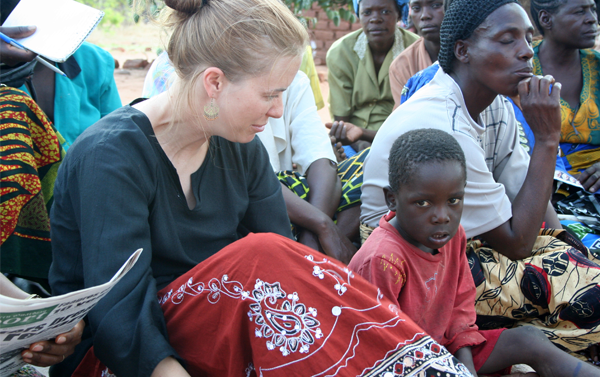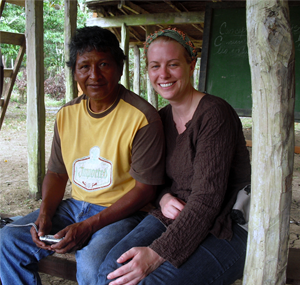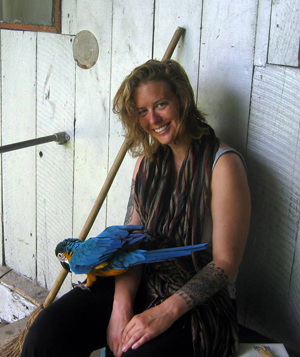Five questions for Revi Sterling
Sterling visits a village in Zambia during work on a Gates Foundation project in Zambia and Zimbabwe.
Failure can be a strong motivator. While working for Microsoft, S. Revi Sterling understood the potential for technology to support positive societal change, but she witnessed numerous examples of well-intentioned efforts come to nothing. She left her research position to pursue a doctorate in Information and Communication Technologies for Development. After graduating from the ATLAS Institute in 2008, she turned her attention to creating a “world-class master’s program for those practitioner-focused students who have a fire in the belly to get out in the world and create opportunities for sustainable and equitable advancement, be it in health, education, livelihoods support, security or any other development sector.”
Now she is faculty director of ICTD Graduate Studies, and because the master’s program is only in its second year, she says she “wears a number of hats that someday (hopefully soon) can sit on someone else’s head.” Sterling created the six core courses for the program and teaches them, as well as other courses in engineering and business. She’s also responsible for everything from setting students up for successful practicum semesters to grant writing, recruiting, advising students, and collaborating with other like-minded programs, including Engineering for Developing Communities, SEEDS (Social Entrepreneurship for Equitable Development and Sustainability), and university Peace Corps efforts.
Sterling spends time relaxing during a project in the Peruvian Amazon with students and faculty from CU-Boulder’s Department of Electrical, Computer, and Energy Engineering.
In addition, she remains active in research and fieldwork focused on, in part, the role of technology in anti-trafficking efforts, community mental health (“Many of the communities where I work have been systematically traumatized by wars, displacement and other forms of disenfranchisement”), fieldwork ethics, and removing barriers to information critical to individual and community empowerment.
The ICTD field and Sterling have grown together. Early practitioners had successes and failures, she says, that demonstrated critical truths: People will only engage with a development initiative to the degree that they perceive its value; technology is not a panacea but a way to support and scale development strategies; and given the marginalized position of the people the program works with, the quality bar of the technology needs to be that much higher.
“So often, ICTD efforts are composed of second-hand computers with no functional, localized software, short research pilots that do not benefit the community but the researcher, and zero assessment and monitoring/evaluation. These three conditions truly keep me up at night, and have motivated the creation of the master’s program.”
1. Why did you choose CU or did it choose you?
In so many ways, CU and I found each other. It is a bit like the love story where the conventional wisdom assures each of us that there is that perfect person out there for us. While I am not that kind of romantic, I will say that CU, and primarily the ATLAS Institute, and I were meant to be together. It was and remains the only program where I could have designed and pursued the doctoral studies that I did, and it is the only school in the United States that could support the program I now run – the Master’s of Science in Information and Communication Technology for Development (MS-ICTD). This burgeoning field requires that students have strength and depth in both computer science and social science, making it a hard fit for a traditional department or college. Because of the structure of ATLAS and the support of the university administration, we are able to offer an interdisciplinary program that graduates students uniquely prepared for the complexity of working in humanitarian technology, while not perpetuating decades of international/community development failures. We come at technology and development through several perspectives that encourage debate, cognitive dissonance, mediation, and practice.
2. You recently were honored with an Anita Borg Women of Vision Award for your accomplishments and contributions concerning women in technology, including a participatory community radio technology you pioneered. Why did you choose to focus on gender and technology in foreign countries?
I was floored when I found out about the award because it’s one of the only “big” awards in the technology and gender space. A good deal of the impetus for the award is the work I did domestically, trying to strengthen the pipeline of women entering computer science and related fields. This was my main focus at Microsoft Research, where I was before coming to CU. I moved my focus from domestic to international as personal technology started to become ubiquitous in developing regions. I was concerned that if there were barriers for American women in high tech, the barriers would be all the more complex and difficult in areas where women do not enjoy the standard of living and opportunities that we have. It’s been demonstrated over and over that a community can only develop to the degree that the women are able to, and yet, ICTD that specifically targets women and girls remains scarce. The AIR project (Advancement through Interactive Radio) is only one of the efforts I’ve worked on to increase women’s participation by bringing their voices into a public, respected, widely available medium in a non-obtrusive, no-cost way. It was the starting point for many other projects that focus on bringing women and their unique development concerns to the community and beyond in a way that ensures the highest level of personal safety and autonomy while keeping outside/research influence to a minimum. Anything that requires my direct interference to work is doomed. My role is to carefully map human needs into technical systems, and get out of the way.
3. What was it like when the community radio technology was used for the first time and how has it changed lives?
There have been a few “goose bump” stories where women have talked about their new-found respect and how that has increased their standing and decreased incidents of domestic violence and other forms of subjugation. These are the stories that make for a great day in the field. I also get chills when I consider some of the work that one of our Ph.D. students is doing in digitizing World Health Organization (WHO) labor monitoring tools because her work will absolutely save lives. However, the reality on the ground is that, no matter how well a technology fits an issue, there is so much that we can’t affect. When I visited one of the communities where I had deployed AIR in 2006, it was exciting to see that the technology was still being used and valued, but several of the women that I worked with could not come to a reunion I held in a central market area because they did not have enough food to be able to walk the distance and back. These are the moments that are heartbreaking and confusing. Am I doing the right thing by creating communication and information channels when basic needs are at risk? But I am not an agricultural or water specialist: I’m a computer nerd and what I can do is link people with the growing numbers of NGO- and citizen-led applications that show where there is available potable water and at what price, or when the World Food Programme will be in the district, or how to migrate to low-water crops.
4. Explain the purpose of an “academic practitioner” and how you developed this idea.
The “academic practitioner” is the technology and development professional who has a strong academic background that will serve her or him well in policy and research circles, a solid understanding and comfort level with myriad fieldwork methods and frameworks to ensure a high level of rigor and integrity, and experience on the ground for at least a semester in order to learn how and when to apply what they’ve learned in the classroom to real life. Of course, many lessons can only be learned through the reality of fieldwork. This is where people learn to become attentive and innovative. I had a student working in rural Nigeria who realized he needed concrete to create a platform for an antennae; he found a road repair team three hours down the road and bartered for the necessary materials. This is just a normal day in the life. Fieldwork also uncovers gaps in education and domain-specific expertise and thus informs the courses that students chose. It’s a Mobius strip – practice informing academe informing practice.
5. What do you consider some of the negatives of technology and can they be minimized?
I rarely blame technology for a failed humanitarian technology effort. This is not to say that technology is a neutral tool; it is embedded in a particular social context and generates responses that run the gamut from aspiration to fear. And yet, the developing world is littered with failed, leftover technology from school projects, civic organizations and research pilots. This is the fault of the people behind the technology. Either they did not pick an appropriate and sustainable technology, or they did not consider maintenance and training, or they placed it in a sub-optimal location in the community. In the worst cases, introducing technology into communities can exacerbate social divides between classes, genders and castes, replicating a have vs. have not situation. It’s horrifying how many well-intended people and projects produce such short-sighted “solutions.” What we need to do is channel this good will and energy into productive development approaches, which is easier said than done. But this is the motivation of the students in the MS-ICTD program. They know they want to improve the standard of living in a community, but they know they don’t quite know how. Making this admission requires a certain level of self-reflexivity and broader world view that is a hallmark of our students.




